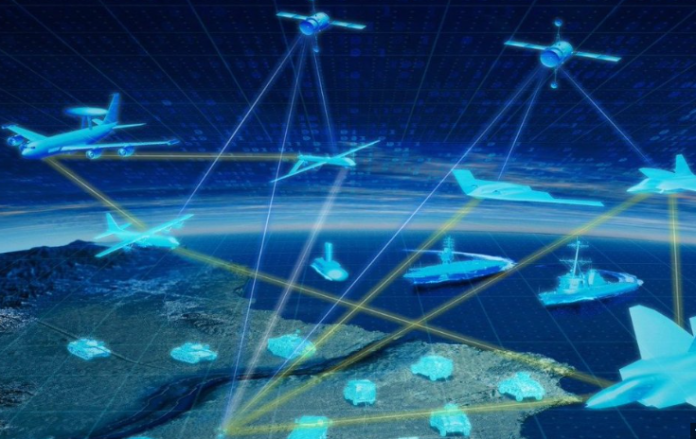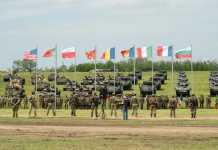Much of the movie “Pulp Fiction” centers around a briefcase and its mysterious contents — an item or items of incredible value and importance never revealed to the audience. It’s a classic MacGuffin, an object in a film that matters only insofar as it motivates the characters and propels the action.
And in some ways, the joint all-domain command and control, or JADC2, the concept is the Defense Department’s MacGuffin — it’s not clear what it is or what it looks like, but it has become one of the driving forces of military modernization and transformation.
The bumper sticker for JADC2 is straightforward: sense, make sense, act. The idea is to link sensor data to command centers to “shooters” — destroyers, jet fighters, missile batteries or ground troops — to take quick action against a target.
But JADC2 is far more than a bumper sticker, and things quickly grow complicated when it comes to building resilient command and control across domains that can function in contested environments — something the military did not face during 20 years of conflict in Afghanistan and Iraq.
According to the Defense Department’s March 2022 unclassified summary of the JADC2 strategy:
“JADC2 provides a coherent approach for shaping future Joint Force [command-and-control] capabilities and is intended to produce the warfighting capability to sense, make sense and act at all levels and phases of war, across all domains and with partners, to deliver information advantage at the speed of relevance.”
No small task. The description continues:
“As an approach, JADC2 transcends any single capability, platform or system; it provides an opportunity to accelerate the implementation of needed technological advancement and doctrinal change in the way the Joint Force conducts [command and control]. JADC2 will enable the Joint Force to use increasing volumes of data, employ automation and AI, rely upon a secure and resilient infrastructure, and act inside an adversary’s decision cycle.”
Thus, JADC2 is a concept, almost a philosophy, as opposed to a single technology, platform or system. In fact, part of the effort is building connectivity among all the disparate platforms and systems in use today that were not designed to communicate with each other and to develop requirements and standards for future systems to be interoperable.
In that regard, JADC2 is not an end state. There won’t be a moment when the system is complete and pulled out of a box like a birthday present.
That has been one of the challenges with the concept: it’s not easy to explain or visualize, said Cynthia Cook, director of the Defense-Industrial Initiatives Group and a senior fellow at the Center for Strategic and International Studies.
“Since it’s such a big and complicated set of programs, and it’s technology, it’s not that people don’t understand it, it just doesn’t have the same visceral connection to people’s lives as an airplane program,” she said.
“Since it’s a bunch of interconnected capabilities that span across different systems, it’s sort of harder for there to be a clear mental picture of what it is,” she added.
Heather Penney, senior fellow at the Mitchell Institute for Aerospace Studies, said getting to a shared understanding of the problem is critical.
“The main challenge that we face is developing the coordination, doctrinal processes and command authorities to execute control over nodes or capabilities that belong to another service,” she said in an interview. “That will be one of the major challenges of moving from this nirvana of everything is connected to everything else.”
She emphasized the need to work out the authorities “to make operations under a JADC2 construct effective and non-chaotic.
“Especially so when we’re talking about real-time targeting or real-time re-targeting, the need to real-time reach into another service to be able to control or task one of their assets,” she added.
“We could self-induce friction in the battle space and de-synchronize other service operations if we don’t have the right insight, awareness, processes and doctrine for doing that,” she said.
So, while the “what it is” of JADC2 might not be clear, how it’s supposed to proceed is clear, at least on paper.
Turning the simple three-function bumper sticker — sense, make sense, and act — into reality will be achieved through five lines of effort, according to the strategy: establish the JADC2 data enterprise; establish its human enterprise; establish its technical enterprise; integrate nuclear command, control and communications with JADC2; and modernize mission partner information sharing.
The JADC2 implementation plan is classified, which adds to the difficulty of assessing the level of progress of the initiative. In addition, the department has struggled with defining requirements and figuring out who should own and oversee its initiatives.
According to a January 2023 Government Accountability Office report, “Battle Management: DoD and Air Force Continue to Define Joint Command and Control Efforts,” the Defense Department and services are still in the early stages of developing JADC2.
“While DoD has made progress in JADC2 planning, it has not yet identified which existing systems will contribute to JADC2 goals or what future capabilities need to be developed,” the report stated. “In addition, DoD is in the process of identifying challenges to implementing JADC2.”
One decision the department made several years ago was to have the Army, Navy and Air Force each move out with its own program to develop the capabilities relevant to a service’s functions and missions.
The Army has Project Convergence, the Navy Project Overmatch and the Air Force the Advanced Battle Management System. The GAO noted that parallel approaches risked the creation of individual JADC2-related capabilities, “which do not necessarily align with DoD’s highest priorities.”
For example, “the Air Force set initial requirements for ABMS in 2018, which is three years before the JADC2 Strategy was approved,” the GAO stated.
CSIS stated in its September 2022 brief, “Pathways to Implementing Comprehensive and Collaborative JADC2” that despite the unifying vision of linking sensors to shooters, the separate “programs vary in approach, due to the different capabilities of each service.
“Project Convergence, the Army’s effort, focuses far more on exercises and experimentation as opposed to engineering enablers for existing capabilities. Project Overmatch and ABMS have a strong engineering emphasis with a focus on technology development, although there are fewer publicly available specifics on Project Overmatch,” the brief stated.
Penney said it is important for there to be some degree of heterogeneity and parallel work to ensure each service gets something it finds useful.
“But then ensure that there’s enough alignment in their efforts, and frankly enough sharing of what they’re doing and involvement with their development of partners and allies, to make sure that partners and allies are involved in the development of these technologies and capabilities and so forth as we move forward,” she said.
Deciding who should oversee and integrate the disparate efforts has been its own challenge, and ownership of JADC2 has changed hands a few times since it was launched.
As of fall 2022, the deputy secretary of defense and vice chair of the Joint Chiefs oversee the Defense Department-wide JADC2 effort. A cross-functional team, component offices under the Office of the Secretary of Defense, military services and combatant commands contribute to the effort, according to the department.
The Chief Digital and Artificial Intelligence Office led by Craig Martell reached full operating capability in June 2022 and is responsible for the data integration layer, which is intended to improve the quality of, access to and interoperability of data required for command and control.
In January, Martell’s office took over the Global Information Dominance Experiments, the first four of which had been run by the North American Aerospace Defense Command and Northern Command.
“The intended outcome of these experiments is two-fold,” Martell said in a Jan. 30 press release about GIDE V. “First, we want to identify where we may have barriers in policy, security, connectivity, user-interface or other areas that prohibit data sharing across the Joint Force.
Second, we want to show how data, analytics and AI can improve joint workflows in a variety of missions from global integrated deterrence through targeting and fires.”
The sixth iteration of these experiments began June 5 and will continue through July 28.
According to background information provided by the Defense Department, military and civilian participants from each of the services and multiple combatant commands are participating virtually and in person to conduct experiments to test, measure, optimize and field JADC2 solutions using artificial intelligence and machine learning technology.
The Chief Digital and Artificial Intelligence Office has three lines of effort in the experiment. A data integration layer technical team is examining the current technical baseline for data integration in the department and the technical needs of the combatant commands.
An experimentation team is testing hypotheses for the data integration layer within realistic strategic and operational joint command-and-control constructs. The team is focusing on common operating and intelligence pictures and testing secure networking and communications, cross-domain information sharing and AI tools.
Lastly, a program management team is developing acquisition strategies in support of the data integration layer.
While early concepts of JADC2 focused on common and open standards and making sure that new systems and technologies play together out of the box, that is now the longer-term focus. In the short term, the new efforts need to work with legacy systems.
Marine Corps Commandant Gen. David Berger noted that during a discussion at the Brookings Institution in May.
“Early on, two or three years ago, there was a notion that we needed to come together on a common set of hardware,” he said. “Now, the notion is keep the hardware that you’ve got. We have to find ways where we can move information between existing programs. This is more software than it is hardware in many cases, not completely.”
Moving to software-defined communications and networking is critical to shrinking command-and-control infrastructure, Berger noted, which is one of the JADC2 goals.
“We have three air wings. We have three pretty large footprint aviation command-and-control systems that govern that,” he said. “All that’s been shrunk down into the back of one or two KC-130s — all domains, aviation, space, cyber, all in a very small form footprint … and we’re driving ourselves down into a much more expeditionary, small version” that can interface with anything from higher levels down to the tactical level.
“So, it’s driving that all into a smaller, more portable, more supportable form factor with a lower signature. That’s where we’re headed,” he added.
Cook noted the change of near-term focus to developing gateways and interfaces that connect existing systems was a necessary, pragmatic shift.
“It’s really hard to get away from legacy systems, in part because as enormous as the defense budget is, it is top-line limited and there’s a lot of hungry mouths to feed,” Cook said.
The department simply can’t invest in a sweeping replacement of all systems and capabilities related to command and control when there is an immediate need to invest in munitions, for example.
Gregory Sanders, deputy director and fellow with the Defense-Industrial Initiatives Group at CSIS, said the JADC2 effort needs an “appetite suppressant.”
“Every sensor, every shooter is bold, inherently, and you have a risk that you’re repeating the Future Combat Systems experience,” he said.
The Future Combat Systems was the failed Army modernization program to develop a networked suite of manned and unmanned systems to replace the M-1 Abrams and M-2 Bradley and other vehicles.
“I think we [need to] focus on what actually needs to work together, and an acknowledgement of legacy is vital there,” Sanders said. “One of the big questions, and I think one of the key things about whether a joint approach really will add a good deal of value, is whether you can incrementally introduce open systems when you’re adding something new.”
Cook said a role for the Chief Digital and Artificial Intelligence Office is to highlight that JADC2 is a journey, not a destination, and that incremental improvements are part of the process.
“So, as the Marines — or whatever other services — have small success along the way to the vision of every shooter and every sensor, celebrate those and don’t say, ‘Well, this is what they’ve done, it’s inadequate,’” she said. “Have the perspective of this is a journey that the services are moving along on, and this is something that works. So, let’s see if we can build on this, [see] if we can get other services to consider it and use this as a springboard for our next success.”
And as if JADC2 isn’t complicated enough as a concept or acronym, another letter is creeping into the mix. Some in the department have been adding “combined,” which reflects the need for partners and allies to be linked in under “CJADC2.”
Bringing allies into the CJADC2 fold will require determining “triggers for sharing data, triggers for sharing data at different levels of classification, working with them so that our systems can share necessary data at different levels of classification,” Cook said.
Then, there is the matter of acquiring joint systems and technologies. The F-35 program provides a cautionary tale about joint acquisition programs, Cook said.
The original concept for the F-35 program was to make a common platform with slight differences for each service. The result was three models with low commonality, she said. And JADC2 requires solutions from the defense industry and the commercial sector, adding to the complexity of the acquisition process, she added.
“The rate of technical development and the source of technical innovation, moving towards non-defense industries, has just shifted,” Cook said. “It’s really going to be a moving target,” which requires a process focus.
“How can the government manage highly complicated, interrelated systems where aspects of it are coming from commercial development?” she continued. “That’s really the sociology problem that needs to be solved.”





